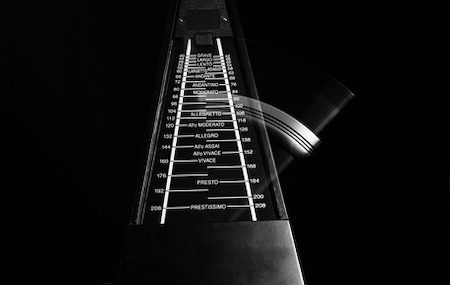A metronome is either a mechanical or electronic device that produces short sound bursts at regular intervals of time. Click. Click. Click. It’s designed to help you set a beat and stick with it as you play.
Metronomes are common instruments used in practice for helping you establish a beat. It’s been used by composers for centuries to help people better understand how the composer designed their songs to be played.
Every song is created with a specific beats per minute – BPM – to let you know how fast or slow the music should go. BPM is also known as tempo.
Think about the tick of a second hand on a clock. It moves at a regular beat – 1, 2, 3, 4, – and so on, always remaining at a steady pace.
BPM is designed to work in a similar way. Some songs may match the natural rhythm of a clock – 1 beat per second. Some songs speed it up, going much faster. Some songs slow it down. 20 BPM isn’t unheard of.
Why use a metronome? It’s designed to help you gain strength in the way you play. It establishes the way a composer created the song. And it also helps you build up your strength in the way the piece should be played.
When you sit down to a brand new song, at the top of the page should be a tempo marking. It might be written as BPM (120 bpm) or as a tempo marketing such as “allegro.” Especially as you are learning more about music, it may be difficult to fully appreciate at what level the song should be played. A metronome gives you that sense of rhythm. It can keep the beat for you to follow as you play the song.
If it’s a fast tempo, it may be hard to begin. Slow it down a bit. Become familiar with the notes and the way the song is played. As your comfort grows, you can increase the beat and pick up the pace until you get it to the desired bpm.
It’s a way to keep you on track throughout your practice.
Of course, you can stick with a traditional mechanical metronome. Or invest in an electronic metronome to sit near your practice area.
Thanks to technology, there are also a variety of apps that can produce the same practice, and allow you to take the technology anywhere.
What type of metronome do you use during your daily practice?


